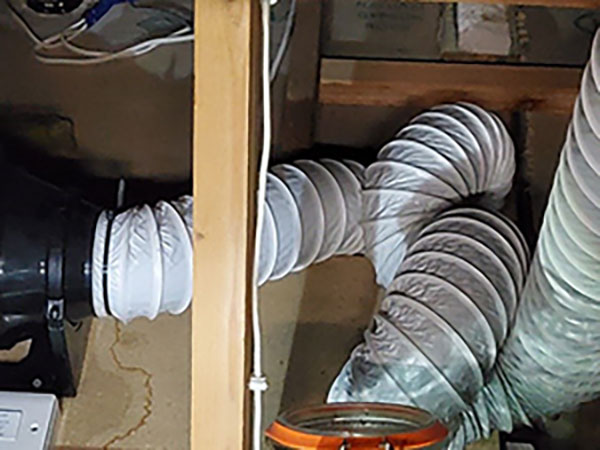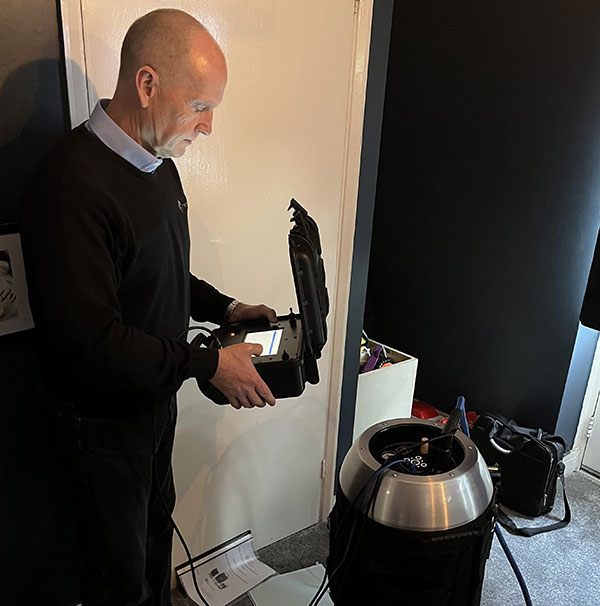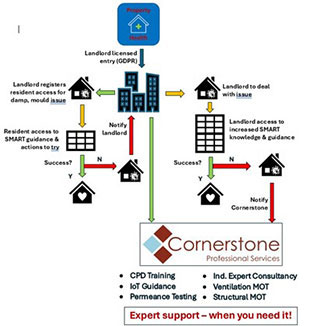David Bly – Managing Director of Cornerstone Management Services Ltd, a company providing independent expert property health surveys is of the opinion more can be done for fighting year-on-year damp, condensation and mould issues in buildings.
For many involved with managing and upholding structural health, it could be argued there needs to be a ‘reset’ with regard to how structures are assessed for these reported issues.
With a proven history providing independent expert surveys into the root causes of damp, condensation and mould, our findings clearly confirm many issues align to the adequate ventilation of a building.
And, in the absence of ‘blame’ aligned to the non-use of installed measures, our experience also highlights installation issues that can and do, contribute to the resultant problems.
Witnessed examples include new extractor installations affecting the existing and future permeability of the building leading to potential secondary impacts with occupants everyday activities plus, poor ducting, inadequate door undercuts, open trickle vents in ‘wet rooms’ alongside misaligned ventilation services in kitchen and bathrooms.
Indeed, the everyday ‘use’ of any installed devices plays an important role in fulfilling ventilation adequacy but equally, residents advising they have not received applicable guidance is also a common comment and, can typically relate to understanding the performance of extractors in and around open windows, leaving doors open, trickle vents open next to working units etc with many an occupant comment being “I didn’t know that”!

Loft ducting
In addition, there have been a number of instances where we have witnessed loft insulation moved aside to facilitate a re-install or reconfiguration of an extraction device with it not replaced post works resulting in temperature differentials across the surfaces.
And, whilst it remains possible to have all operating devices fully compliant with applicable Approved Documents and utilised by occupants, mould can and does develop in these temperature differing areas.
Cornerstone are of the opinion ‘blame’ can be replaced with ‘did you know’ since many occupants may not be aware of the impact some everyday activities have on the internal conditions as a whole and, sharing knowledge and guidance in a defined recognisable manner could be a significant consideration when commencing an investigation into a reported problem.
We know the UK have a myriad of building stock construction types, periods and methods and, with this in mind, any inspections for reported damp and mould or indeed any designated structural or atmospheric improvements must, in our opinion, embrace these important elements as they can all play an active role in maintaining desired structural health goals.
The existing permeability of a structure i.e. it’s leakiness, is also a key recognition prior to any intended ‘improvements’ as it affects the prevailing atmospheric conditions alongside the resultant internal comfort of occupants as it directly relates to upholding the ‘Whole Dwelling Ventilation Rate’.
With a recognised goal for decarbonisation ahead, in the absence of structural and atmospheric understanding, could we witness more problems in the future due to a gap in their joint expertise.

Permeability testing
New legislation also calls for timely responses to reported issues and qualifications for those dealing with managing property health. Therefore, a strong desire to embrace change with defined key knowledge for meeting compliance and effectivity within the stipulated timelines must be a new goal.
CPD Accredited training for understanding Damp & Mould for all administrative and technical staff levels is an option for implementing a greater understanding through organisation staff seeking to not only underpin solutions with greater confidence but, submit recognisable knowledge in a simplistic manner for occupants at the outset for immediate guidance and measures capable of assisting likely causes and minor measures for early resolution attempts.
With a greater understanding for all involved including occupants armed with more feasible understandings of their property and atmospheric management, this will not only aid reducing the annual spend but, will reduce any ‘re-spend’ activities armed with a greater understanding of improvement expectations.
However and of note, whilst it is fully recognised not all occupants will embrace guidance for their everyday activity management, it is Cornerstone’s belief many will indeed embrace a ‘I didn’t know that’ perspective if it aligns to improved internal health in the building they occupy.
Cornerstone are of the opinion an improved approach can be achieved by re-thinking how complaints are recorded, how responses are managed and how credible knowledge in a recognised format can be utilised and delivered to occupants for greater understanding and improved conformity.
One key start point is recognising damp and mould are separate elements and alone would require bespoke approaches for each issue because damp tends to identify itself with spoiling, blistering, cracking and darkening of affected surfaces etc. Mould however can reside on any surface where respective nutrients are available including structures and contents items and, if the conditions are suitable and not disturbed for a number of days, their development can occur in the absence of wet or damp buildings.
 To aid this journey, Cornerstone are sharing their knowledge in a unique Property Health Application that allows landlords and property managers to register their occupants online in full GDPR compliance with immediate 24/7 guidance for a visual issue alongside simplistic yet key opportunities to resolve the matter ahead of a formal complaint.
To aid this journey, Cornerstone are sharing their knowledge in a unique Property Health Application that allows landlords and property managers to register their occupants online in full GDPR compliance with immediate 24/7 guidance for a visual issue alongside simplistic yet key opportunities to resolve the matter ahead of a formal complaint.
If this issue is not resolved, images and notes can be sent back to the landlord/manager for a proactive resolution.
The knowledge is delivered in a sensible and recognisable format for all concerned and, if complex cases still persist, Cornerstone remain ready to assist – when you need them!
A greater understanding of structural and atmospheric behaviour with a uniform approach will underpin landlord confidence with their improvements concluded in a defined approach whilst providing bespoke guidance to occupants for an improved healthier internal living and working condition.
In addition, key trend data for ongoing stock management is a system deliverable since each landlord/management company will likely be maintaining a host of structural types and geographical locations across the United Kingdom.
To learn more of the unique Application and how you can obtain a complimentary trial period, or discuss any issues, contact us on:
David Bly
Managing Director
Cornerstone Management Services Ltd
Web: www.cornerstone-ltd.co.uk and ‘enquire today’.
Email: info@cornerstone-ltd.co.uk
Call: 0345 846 0955
Image © Cornerstone
- Log in to post comments













